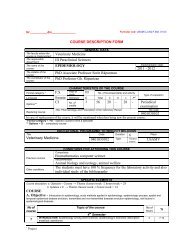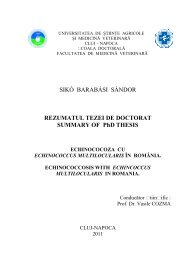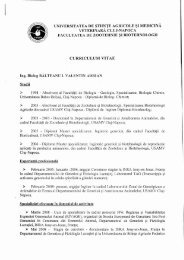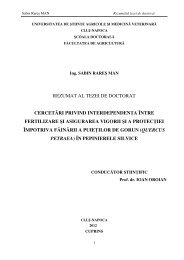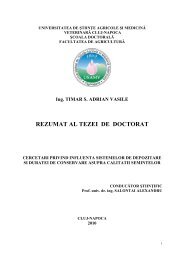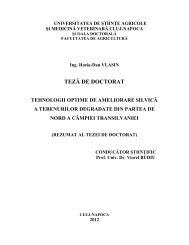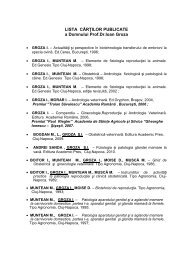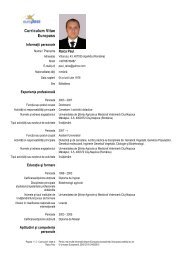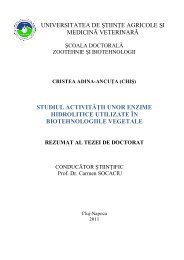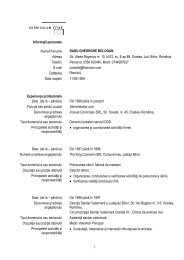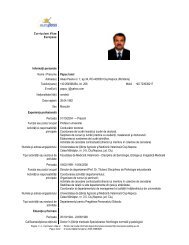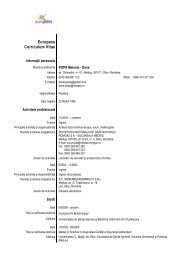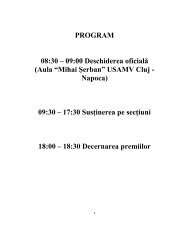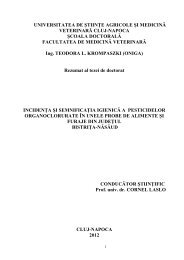rezumat final - USAMV Cluj-Napoca
rezumat final - USAMV Cluj-Napoca
rezumat final - USAMV Cluj-Napoca
You also want an ePaper? Increase the reach of your titles
YUMPU automatically turns print PDFs into web optimized ePapers that Google loves.
Criptosporidioza vi eilor i iezilor: cercetări privind diagnosticul, epidemiologia i<br />
etiopatogeneza<br />
UNIVERSITATEA DE STIINTE AGRICOLE SI MEDICINĂ VETERINARĂ<br />
CLUJ-NAPOCA<br />
SCOALA DOCTORALĂ<br />
FACULTATEA DE MEDICINĂ VETERINARĂ<br />
ALEXANDRU LUCIAN BEJAN<br />
REZUMAT AL TEZEI DE DOCTORAT<br />
CLUJ-NAPOCA<br />
2009<br />
CONDUCĂTOR STIINTIFIC<br />
Prof. dr. Vasile COZMA<br />
a
Criptosporidioza vi eilor i iezilor: cercetări privind diagnosticul, epidemiologia i<br />
etiopatogeneza<br />
UNIVERSITATEA DE STIINTE AGRICOLE SI MEDICINĂ VETERINARĂ<br />
CLUJ-NAPOCA<br />
SCOALA DOCTORALĂ<br />
FACULTATEA DE MEDICINĂ VETERINARĂ<br />
ALEXANDRU LUCIAN BEJAN<br />
CRIPTOSPORIDIOZA VITEILOR SI IEZILOR: CERCETĂRI<br />
PRIVIND DIAGNOSTICUL, EPIDEMIOLOGIA SI<br />
ETIOPATOGENEZA BOLII<br />
REZUMAT AL TEZEI DE DOCTORAT<br />
CLUJ-NAPOCA<br />
2009<br />
CONDUCĂTOR TIIN IFIC<br />
Prof. dr. Vasile COZMA<br />
b
Criptosporidioza vi eilor i iezilor: cercetări privind diagnosticul, epidemiologia i<br />
etiopatogeneza<br />
CRIPTOSPORIDIOZA VITEILOR SI IEZILOR: CERCTĂRI PRIVIND<br />
DIAGNOSTICUL, EPIDEMIOLOGIA SI ETIOPATOGENEZA BOLII<br />
REZUMAT<br />
Criptosporidioza este o bolă întâlnită la om şi animale, cu evoluŃie favorabilă la<br />
organismele imunocompetente şi gravă la cele imunodeficitare, caracterizată din punct de<br />
vedere clinic, în principal, prin tulburări gastrointestinale şi mai rar prin cele respiratorii,<br />
hepatice şi pancreatice. Boala are un caracter de zoonoză, deoarece se transmite de la<br />
animale la om.<br />
Pierderile economice la animale, asociate cu această boală, nu sunt reflectate doar<br />
în mortalitate, dar şi în întârzieri în creştere, costul medicamentelor şi asistenŃa<br />
veterinară.<br />
Interesul faŃă de protozoarul Cryptosporidium s-a răspândit din aria sa academică<br />
a biologilor şi parazitologilor, la medicii veterinari, medicii epidemiologi, farmacologi,<br />
specialişti în domeniul sănătăŃii publice, a apei potabile, a fermierilor şi publicului în<br />
general. Preocuparea pentru prevenirea şi tratamentul criptosporidiozei, se extinde de la<br />
comunităŃile subdezvoltate la societăŃile puternic industrializate, de la persoanele<br />
imunosupresate, la populaŃia sănătoasă.<br />
După anul 1990, s-au efectuat numeroase cercetări şi s-a constatat că în apa<br />
consumată de om şi animale se găsesc destul de frecvent oochisturi de Cryptosporidium.<br />
Sunt citate 19 izbucniri de criptosporidioză cu origine acvatică, cu afectarea aproximativ<br />
a 427000 de oameni. Cu toate tratamentele şi filtrările apei de robinet, nu se poate garanta<br />
absenŃa oochisturilor de Cryptosporidium parvum. Apa reprezintă vehiculul major pentru<br />
transmiterea criptosporidiozei la animale i oameni.<br />
c
Obiectivele lucrării<br />
Criptosporidioza vi eilor i iezilor: cercetări privind diagnosticul, epidemiologia i<br />
etiopatogeneza<br />
Primul capitol de cercetări proprii î i propune să evalueze 6 tehnici diferite de<br />
diagnostic (2 metode de colorare, o metodă de flota ie, 2 metode imunologice i o<br />
metodă de biologie moleculară) din punct de vedere al eficien ei, al sensibilită ii i<br />
specificită ii, al costului, timpului i u urin ei realizării.<br />
O dată stabilită cea mai convenabilă tehnică de diagnostic din punct de vedre<br />
economic, al u urin ei realizării i nu în ultimul rând al sensibilită ii i<br />
specificită ii, cercetările ulterioare au fost realizate doar prin această metodă.<br />
Al doilea capitol de cercetări proprii î i propune analiza evolu iei<br />
criptosporidiozei la diferite categorii de vi ei i iezi, urmărindu-se câteva direc ii<br />
principale. Astfel, s-a realizat un studiu epidemiologic descriptiv, pentru cunoa terea<br />
frecven ei i prevalen ei bolii la vi ei i iezi; s-a urmărit influen a vârstei sexului<br />
i a varia iilor sezoniere asupra evolu iei bolii; s-a identificat specia de<br />
Cryptosporidium ce afectează vi eii prin micromăsurători, dar i prin tehnici de<br />
biologie moleculară; nu în ultimul rând s-a realizat un studiu al parazitozelor ce afectează<br />
vi eii cu vârsta cuprinsă între o zi i 8 săptămâni.<br />
Al treilea capitol de cercetări proprii vizează stabilirea locului criptosporidiozei în<br />
etiologia diareei neonatale la vi ei. Astfel, s-a urmărit frecven a eliminărilor de<br />
cryptosporidium spp., E. coli factorul F5, rotavirus i coronavirus la vi eii din centrul<br />
i nord-vestul României i s-a încercat identificarea unor corela ii existente între<br />
gravitatea manifestărilor clinice, agen ii etiologici biotici i severitatea anomaliilor<br />
biochimice i hematologice la vi eii afecta i de diaree neonatală.<br />
Al patrulea capitol de cercetări proprii î i propune semnalarea unui focar de<br />
criptosporidioză caprină, de la manifestările clinice apărute până la descrierea integrală a<br />
patogenezei criptosporidiozei intestinale la tineretul caprin.<br />
Ultimul capitol de cercetări proprii urmăre te evaluarea dinamicii<br />
coproeliminărilor de oochisturi de Cryptosporidium i evaluarea parametrilor<br />
hematologici în vederea determinării răspunsului sistemic, la iezii infecta i experimental<br />
cu oochisturi de Cryptosporidium spp.<br />
d
Criptosporidioza vi eilor i iezilor: cercetări privind diagnosticul, epidemiologia i<br />
etiopatogeneza<br />
EVALUAREA COMPARATIVĂ A METODELOR DE DIAGNOSTIC<br />
UTILIZATE PENTRU DETECTAREA OOCHISTURILOR DE<br />
CRYPTOSPORIDIUM SPP.<br />
Acest studiu i-a propus să evalueze 6 tehnici de diagnostic (colora ia<br />
Henriksen, colora ia Gunther, metoda flota iei cu zaharoză, metoda ELISA, metoda<br />
imunocromatografică i tehnica PCR).<br />
Au fost luate în studiu un număr total de 195 de probe de fecale, provenite de la<br />
vi ei cu vârsta cuprinsă între o zi i 6 săptămâni. Probele au fost recoltate individual de<br />
la nivel rectal i păstrate la 4ºC.<br />
Colorația Henriksen. Este o metodă de bază pentru identificarea<br />
criptosporidiilor. Prin această tehnică, oochisturile apar de culoare roşu viu, net<br />
delimitate, pe un fond verde sau verde-albăstrui, dacă frotiul este realizat mai gros<br />
Colorația Gunther. Este o altă metodă de bază pentru identificarea<br />
criptosporidiilor. Prin această tehnică, oochisturile apar de culoare albastră pe un fond<br />
roşu.<br />
Metoda de flotație cu zaharoză (Steather). Această metodă se bazează pe<br />
flotarea şi ridicarea ouălor uşoare şi a oochisturilor la suprafaŃa soluŃiei suprasaturate de<br />
zaharoză şi aderarea acestora la o suprafaŃă de sticlă.<br />
Metoda coproELISA. Este o metodă extrem de utilizată pentru depistarea<br />
antigenelor de Cryptosporidium spp. din fecale. Pentru realizarea acestei metode am<br />
folosit kitul BIO K-070 (BioX Diagnostics, Jemelle, Belgium).<br />
Metoda imunocromatografică. Este o metodă de depistare a antigenelor de<br />
Cryptosporidium spp. din probele de fecale. Acest test a fost realizat în concordan ă cu<br />
instruc iunile producătorului, utilizând kitul de diagnostic BIO K-155 (BioX<br />
Diagnostics, Jemelle, Belgium).<br />
Tehnica PCR. Pentru realizarea acestei tehnci, s-au urmărit următoarele etape:<br />
extrac ia ADN-ului, amplificarea prin nested PCR, migrarea probelor în gelul de agar<br />
i citirea rezultatelor. Extrac ia s-a realizat utilizând QIAamp DNA kit (Qiagen).<br />
Amplificarea propriu-zisă s-a făcut prin nested PCR utilizând următorii primeri: SSU-1<br />
(5`-GAT TAA GCC ATG CAT GTC TAA G-3`), SSU-2 (5` -TTC CAT GCT GGA<br />
e
Criptosporidioza vi eilor i iezilor: cercetări privind diagnosticul, epidemiologia i<br />
etiopatogeneza<br />
GTA TTC AAG- 3`), SSU-3 (5`-CAG TTA TAG TTT ACT TGA TAA TC-3`) i SSU-<br />
4 (5`-CCT GCT TTA AGC ACT CTA ATT TTC-3`). Migrarea produ ilor de<br />
amplificare s-a realizat prin electroforeză orizontală în gel de agaroză 1,5%, la 80 V, timp<br />
de 60 de minute. După migrarea probelor în gelul de agaroză, imaginea gelului cu<br />
fragmentele de ADN după migrare a fost fotografiată, utilizând aparatul BioDoc-IT TM<br />
Imaging System<br />
Analiza statistică a rezultatelor a fost făcută cu ajutorul programelor Epi Info<br />
3.5.1, Win Episcope 2.0 i Statistica. Astfel, s-au calculat: sensibilitatea, specificitatea,<br />
valoarea predictivă pozitivă, valoarea predictivă negativă, prevalen a adevărată,<br />
prevalen a aparentă, coeficientul de concordan ă între teste k, indicele Youden i<br />
indicele Spearman.<br />
Rezultate<br />
Prevalen a maximă a fost pusă în eviden ă prin colora ia Henriksen (18,5%), în<br />
vreme ce prevalen a minimă s-a observat prin metoda Steather (7,4%). Valori medii au<br />
fost observate prin metoda coproELISA (16,9%), colora ia Gunther (16,4%), metoda<br />
PCR (14,8) i metoda imunocromatografică (13,33%.). În figura 1 se observă<br />
prevalen a criptosporidiozei prin cele 6 metode diferite de diagnostic.<br />
Fig. 1. Reprezentarea grafică a cazurilor pozitive i negative pentru Cryptosporidium spp., prin cele 6<br />
metode de diagnostic<br />
Sensibilitatea cea mai ridicată s-a înregistrat în cazul metodei Henriksen (91,89%),<br />
urmată de metodele Gunther (83,78%), PCR (75%) i coproELISA (72,97%), iar<br />
sensibilitatea cea mai scăzută s-a înregistrat în cazul metodei Steather (44%).<br />
f
Criptosporidioza vi eilor i iezilor: cercetări privind diagnosticul, epidemiologia i<br />
etiopatogeneza<br />
Specificitatea tehnicilor studiate a fost peste 95%, fiind chiar 100% pentru metodele<br />
Steather i PCR.<br />
Metodele coproscopice de depistare a oochisturilor de Cryptosporidium spp. sunt<br />
cele mai ieftine, în vreme ce tehnicile coproELISA i PCR au costul consumabilelor<br />
foarte ridicat i necesită investi ii mari în aparatură. Cea mai expeditivă metodă este<br />
metoda imunocromatografică, în vreme ce metoda PCR este metoda cea mai laborioasă.<br />
Dintre metodele cu sensibilitate ridicată, colora ia Ziehl-Neelsen, modificată de<br />
Henriksen, este cea mai convenabilă din punct de vedere economic, dar i din punct de<br />
vedere al u urin ei i timpului necesar realizării.<br />
STUDII EPIDEMIOLOGICE ÎN CRIPTOSPORIDIOZĂ LA VIțEI țI IEZI DIN<br />
CENTRUL țI NORD-VESTUL ROMÂNIEI<br />
Acest studiu a avut drept scop analiza evolu iei criptosporidiozei la diferite<br />
categorii de vi ei i iezi, urmărindu-se prevalen a, influen a vârstei, sexului i a<br />
varia iilor sezoniere asupra evolu iei bolii i identificarea speciilor de<br />
Cryptosporidium ce afectează vi eii i iezii prin micromăsurători i tehnici de biologie<br />
moleculară.<br />
Au fost lua i în studiu un număr total de 708 vi ei, proveni i din 29 de ferme de<br />
bovine i 412 iezi proveni i din 12 ferme de caprine din centrul i nord-vestul<br />
României. Pentru punerea în eviden ă a oochisturilor de Cryptosporidium spp. s-a<br />
utilizat colora ia Henriksen. Au fost efectuate micromăsurători pe un număr de 20 de<br />
oochisturi cu ajutorul programului AdobePhotoshop CS 4, pe imagini obŃinute la<br />
microscopul Olympus BSX430 cu obiectivul cu imersie. Pentru determinarea speciilor de<br />
Cryptosporidium prin tehnici de biologie moleculară s-a utilizat tehnica Multiplex PCR<br />
folosind gena Hsp 70. Pentru aceasta, s-au folosit primeri specifici pentru următoarele 4<br />
genotipuri investigate: Cryptosporidium parvum (genotipul uman), Cryptosporidium<br />
parvum (genotipul bovin), Cryptosporidium canis i Cryptosporidium felis.<br />
Rezultate<br />
g
Criptosporidioza vi eilor i iezilor: cercetări privind diagnosticul, epidemiologia i<br />
etiopatogeneza<br />
A. La vi ei. Din cei 708 viŃei cu vârsta cuprinsă între o zi şi 8 săptămâni luaŃi în<br />
studiu, 198 de viŃei au fost eliminatori de oochisturi de Cryptosporidium spp., adică<br />
27,96% (95% IC =24,7%- 31,5%).<br />
Eliminări de oochisturi de Cryptosporidium spp. s-au înregistrat încă de la vârsta<br />
de 4 zile, prevalen a cea mai mare constatându-se între 2 şi 3 săptămâni (fig. 2). Faptul<br />
că infec ia cu Cryptosporidium spp. a fost diagnosticată atât de timpuriu, sugerează o<br />
contaminare foarte mare a acestei zone. Cea mai mare intensivitate a parazitării cu<br />
Cryptosporidium spp. s-a observat la categoria de vârstă 1-2 săptămâni, unde 54% din<br />
cazuri au prezentat intensivitate medie şi 38% din cazuri intensivitate crescută, în vreme<br />
ce la categoriile de vârstă sub o săptămână şi peste 3 săptămâni, s-a înregistrat o<br />
intensivitate scăzută (fig. 3).<br />
Fig. 2. Prevalen a criptosporidiozei (%) la viŃei<br />
în funcŃie de vârstă<br />
Fig. 3. Intensivitatea parazitării cu<br />
Cryptosporidium spp. în funcŃie de vârstă<br />
Cele mai mari valori ale inciden ei infec iei cu Cryptosporidium spp. s-au<br />
înregistrat la sfâr itul iernii - începutul primăverii, când au ajuns la 70,21%, în vreme ce<br />
în restul anului, valorile au fost de 16,80 ± 5,78%.<br />
Prin micromăsurătorile oochisturilor de Cryptosporidium spp. s-a depistat<br />
eliminarea unui singur tip de oochist cu dimensiunile de 4,51 ± 0,41 µm lungime i 4,07<br />
± 0,33 µm lă ime, având o formă u or ovală.<br />
Pe baza analizei genei SSU rRNA, prin nested PCR s-a depistat, la 8 probe,<br />
amplificarea unui fragment de 638 bp, specific genului Cryptosporidium. Din cele 8<br />
probe, 5 au fost pozitive pentru Cryptosporidium parvum human genotype (62,5%) i 3<br />
au fost pozitive pentru Cryptosporidium parvum bovine genotype (37,5%) (fig. 4). Nu s-a<br />
h
Criptosporidioza vi eilor i iezilor: cercetări privind diagnosticul, epidemiologia i<br />
etiopatogeneza<br />
pus în eviden ă nici o probă pozitivă pentru Cryptosporidium canis i Cryptosporidium<br />
felis.<br />
Fig. 4. Identificarea speciilor de Cryptosporidium prin tehnica PCR: coloana 1 - rulerul, coloanele 2 i 6<br />
- probe pozitive pentru Cryptosporidium parvum human genotype, coloanele 3 i 4 - probe negative<br />
pentru Cryptosporidium, coloana 5 - probă pozitivă pentru Cryptosporidium parvum bovine genotype<br />
Asocia iile parazitare întâlnite la vi ei de 0-8 săptămâni au fost:<br />
Cryptosporidium spp. i Eimeria spp.(6,8%), Eimeria spp. i Strongyloides spp. (0,7%),<br />
iar la 3 vi ei s-a observat asocierea dintre Eimeria spp., Strongyloides spp. i Giardia<br />
spp. (0,42%). Eliminări de oochisturi de Cryptosporidium spp. i Eimeria spp. au fost<br />
identificate în majoritatea fermelor de bovine studiate: 79,31% respectiv 68,96% din<br />
ferme.<br />
Acest studiu este primul studiu sistematic al prevalen ei criptosporidiozei la<br />
bovine în România i demonstrează că acest parazit este foarte răspândit, fiind prezent în<br />
79,31% din fermele de bovine din centrul i nord-vestul României.<br />
B. La iezi. Din cei 412 iezi cu vârsta cuprinsă între o zi şi 6 săptămâni luaŃi în<br />
studiu, 99 de iezi eliminau oochisturi de Cryptosporidium spp., adică 24 % (95% IC<br />
=20,0% - 28,5%).<br />
1 2 3 4 5 6<br />
Prevalen a cea mai mare a criptosporidiozei la iezi s-a constatat la categoriile de<br />
vârstă 1-2 săptămâni (39,4%), respectiv 2-3 săptămâni (30,2%), eliminări de oochisturi<br />
de Cryptosporidium spp. înregistrându-se încă de la vârsta de 4 zile.<br />
i
Criptosporidioza vi eilor i iezilor: cercetări privind diagnosticul, epidemiologia i<br />
etiopatogeneza<br />
Din totalul iezilor examina i, 349 nu manifestau nici un simptom, în vreme ce 63<br />
de iezi, manifestau simptome exprimate clinic prin diaree galbenă. Dintre cei 63 de iezi<br />
cu diaree, 52 (82,5%) eliminau oochisturi de Cryptosporidium spp., iar 11 (17,5%) nu<br />
eliminau oochisturi. În cazul iezilor fără diaree, din 349 de iezi lua i în studiu, doar 47<br />
(13,5%) eliminau oochisturi de Cryptosporidium spp.<br />
Criptosporidioza caprină a evoluat înso ită de simptome exprimate clinic prin<br />
diaree doar în 52,52% din cazuri, în restul cazurilor, aceasta evoluând asimptomatic.<br />
Distribu ia criptosporidiozei la iezi în func ie de sex a fost uniformă.<br />
Riscul zoonotic al criptosporidiozei bovine i caprine poate fi determinat doar<br />
prin tehnici de biologie moleculară care identifică cu exactitate specia implicată în<br />
declan area infec iei. Orice efort menit a controla această infec ie la om i animale<br />
trebuie să fie direc ionat spre aceste specii i categorii de vârstă.<br />
ROLUL CRIPTOSPORIDIILOR ÎN ETIOLOGIA țI PATOGENEZA<br />
SINDROMULUI DE DIAREE NEONATALĂ LA VIțEI<br />
Acest studiu a avut drept scop analiza evolu iei criptosporidiozei în cadrul<br />
sindromului de diaree neonatală la vi ei, urmărindu-se următoarele direc ii principale:<br />
• stabilirea locului criptosporidiozei în etiologia diareei neonatale, la vi ei, prin<br />
determinarea frecvenŃei eviden ierii Rotavirus, Coronavirus, E. coli F5 şi<br />
Cryptosporidium parvum,<br />
• identificarea unor corelaŃii existente între gravitatea manifestărilor clinice, agenŃii<br />
etiologici biotici i patogeneză, respectiv severitatea modificărilor biochimice şi<br />
hematologice la viŃeii afectaŃi de diareea neonatală.<br />
Cercetările au fost efectuate pe un efectiv total de 110 vi ei provenind din 3<br />
jude e din zona de centru i nord-vest a României. S-au recoltat probe de fecale de la<br />
fiecare individ în parte prin tu eu rectal, urmărindu-se prezen a sau absen a<br />
coproantigenelor de rotavirus, coronavirus, E. coli factorul F5 i Cryptosporidium spp.,<br />
utilizând kitul Bio-X Duo Digestive ELISA Kit.<br />
Pentru realizarea studiului clinic i paraclinic în SDN, bolnavii au fost împărŃiŃi,<br />
în funcŃie de gravitatea simptomelor, în două loturi.<br />
j
Criptosporidioza vi eilor i iezilor: cercetări privind diagnosticul, epidemiologia i<br />
etiopatogeneza<br />
Lotul nr. 1 a fost alcătuit din 10 viŃei prezentând simptome de enterită catarală.<br />
Lotul nr. 2 a fost alcătuit din 9 viŃei prezentând simptome de enterită hemoragică.<br />
Rezultate<br />
Cryptosporidium parvum este cel mai frecvent agent patogen implicat în SDN cu<br />
o prevalen ă de 35,45%, în 16,36% din cazuri ca unic agent patogen i, în 19,09% din<br />
cazuri, în asocia ie cu al i enteropatogeni. Infec ia cu rotavirus a fost identificată în<br />
17,27% din cazuri, din care în 7,27% din cazuri ca unic agent patogen i în 10% în<br />
asocia ie cu al i enteropatogeni. Infec ia cu coronavirus, a fost identificată în 17,27%<br />
din cazuri, din care în 2,73% din probe ca unic agent patogen i în 14,54% din probe în<br />
asocia ie cu Cryptosporidium parvum. Infec ia cu E.coli factorul F5 a fost identificată<br />
doar în 1,82% din cazuri. 52,27% din probe au fost negative pentru to i cei 4<br />
enteropatogeni cerceta i.<br />
Prevalen a criptosporidiozei a fost cea mai mare în jude ul <strong>Cluj</strong> (50%), în vreme<br />
ce, în cazul infec iilor cu rotavirus i coronavirus prevalen ele cele mai mari s-au<br />
înregistrat în jude ul Satu-Mare, 24,24, respectiv 39,39% (fig. 5).<br />
Infec ia cu Cryptosporidium parvum a fost cel mai des întâlnită la vârsta de 1-2<br />
săptămâni (56,75%) i 2-3 săptămâni (46,15%). Infec iile cu rotavirus i respectiv<br />
coronavirus au fost cel mai des identificate la categoria de vârstă 1-2 săptămâni în<br />
procente de 35,13 respectiv 29,72%. Infec ia cu E. Coli, factorul enteropatogen F5, a<br />
fost identificată doar la categoria de vârstă sub o săptămână, la doi vi ei având 5,<br />
respectiv 7 zile (fig. 6).<br />
Fig. 5. Reprezentarea grafică a ponderii celor 4<br />
enteropatogeni în cele 3 jude e<br />
Fig. 6. Reprezentarea grafică a ponderii celor 4<br />
enteropatogeni în func ie de vârstă<br />
k
Criptosporidioza vi eilor i iezilor: cercetări privind diagnosticul, epidemiologia i<br />
etiopatogeneza<br />
Sindromul de diaree neonatală la viŃei are o exprimare clinică de gravitate<br />
variabilă care rezultă din interacŃiunea complexă dintre factorii de risc, factorii<br />
declanşatori şi reactivitatea organismului nou-născut. Formele clinice cele mai grave au<br />
fost cele consecutive enteritelor hemoragice în care, alături de deshidratare şi acidoză<br />
metabolică, au evoluat cu efecte agravante anemia şi endotoxemia.<br />
În etiologia SDN la viŃeii cu simptome de enterită catarală nu s-au identificat<br />
agenŃi biotici. La cazurile cu simptome de enterită hemoragică, agenŃii patogeni implicaŃi<br />
au fost reprezentaŃi de Cryptosporidium spp. (66,7%), Eimeria spp. (22,22%), Rotavirus<br />
(11,1%), Coronavirus (11,1%).<br />
Deshidratarea hipertonă şi acidoza metabolică lactică au fost dominantele<br />
patogenetice majore care au marcat sindromul umoral, atât în formele uşoare, cât şi în<br />
cele grave ale sindromului de diaree neonatală. Hipoglicemia evidenŃiată la ambele loturi<br />
de viŃei constituie un element patogenetic major care rezultă în urma anorexiei,<br />
maldigestiei şi malabsorbŃiei.<br />
Fibrinogenul plasmatic reprezintă un indicator umoral foarte sensibil şi fiabil în<br />
afecŃiunile inflamatorii gastro-intestinale la viŃeii nou născuŃi.<br />
CRIPTOSPORIDIOZA NATURALĂ LA IEZI, ÎNTR-UN FOCAR DIN JUDEțUL<br />
CLUJ – OBSERVAțII EPIDEMIOLOGICE, CLINICE, MORFOPATOLOGICE<br />
țI ELECTRONOMICROSCOPICE<br />
Scopul acestui studiu a fost de a descrie un focar natural de criptosporidioză a<br />
iezilor, de la modificările clinice apărute, până la descrierea patogenezei bolii.<br />
În februarie 2009, a fost identificat un focar de criptosporidioză cu diaree apoasă<br />
galbenă, la iezi cu vârsta cuprinsă între o zi i 3 săptămâni, la o fermă de caprine din<br />
jude ul <strong>Cluj</strong>. Fecalele a 58 de iezi mor i i 83 de iezi în via ă au fost prelucrate prin<br />
metode coproparazitologice, în vederea identificării agen ilor patogeni implica i. La 10<br />
cadavre s-a făcut examenul necropsic constând în: examen macroscopic, examen<br />
histopatologic i examen electronomicoscopic.<br />
Rezultate<br />
l
(87 / 141).<br />
Criptosporidioza vi eilor i iezilor: cercetări privind diagnosticul, epidemiologia i<br />
etiopatogeneza<br />
Prevalen a criptosporidiozei la iezi în cadrul focarului semnalat a fost de 61,70%<br />
Manifestările clinice observate au fost diaree la 68,68% din iezi (57 / 83), cifoză,<br />
la 9,64% din iezi (8 / 83) i deshidratare la 44,58% din iezi (37/83). Mortalitatea iezilor,<br />
în focarul studiat a fost de 41,13%.<br />
Coproeliminări de oochisturi de Cryptosporidium spp. au fost observate la 81,6%<br />
din efectiv (115 / 141).<br />
La examenul anatomopatologic s-au observat cadavre cahectice cu trenul posterior<br />
murdărit cu fecale. Macroscopic, s-a observat conŃinutul intestinal apos, cu fecale<br />
galbene i ansele intestinale destinse de gaze.<br />
Modificările histologice observate în ileon i colon au inclus alteraŃii ale<br />
vilozităŃilor caracterizate prin atrofia i denudarea acestora.<br />
La suprafa a marginei luminale a enterocitelor s-au eviden iat oochisturile de<br />
Cryptosporidium, păstrând citoarhitectonica acestora (fig. 7). Unele enterocite parazitate<br />
prezentau distrofie vacuolară.<br />
La nivelul laminei propria s-a observat o congestie a acesteia i un infiltrat<br />
inflamator discret reprezentat din limfocite i celule polimorfonucleare.<br />
La nivelul cecumului, mucoasa intestinală a fost intactă i prezenta numero i<br />
parazi i la suprafa ă (fig. 8).<br />
Fig. 7. Sec iune la nivelul ileonului distal:<br />
dispari ia microvililor de pe zonele unde sunt<br />
prezen i parazi ii, u or infiltrat inflamator cu<br />
polimorfonucleate (HE x 1000)<br />
Fig. 8. Sec iune prin por iunea proximală a<br />
cecumului: mucoasa intestinala intactă cu<br />
prezen a a numeroase oochisturi la suprafa ă<br />
(HE x 400)<br />
m
Criptosporidioza vi eilor i iezilor: cercetări privind diagnosticul, epidemiologia i<br />
etiopatogeneza<br />
Criptosporidiile, în sec iunile histologice i electronomicroscopice de la nivelul<br />
ileonului, au apărut ca forma iuni sferice sau ovale, de diverse dimensiuni, înglobate în<br />
marginea în perie a enterocitelor (fig. 9).<br />
Electronomicroscopic, s-a observat tapetarea mucoasei intestinale cu oochisturi de<br />
Cryptosporidium spp. (fig. 10).<br />
Prin mărirea la scară mare a epiteliului ileal cu Cryptosporidium s-a observat<br />
atrofia i denudarea vilozită ilor intestinale.<br />
Fig. 9. Scanning electronomicroscopic al<br />
mucoasei ileonului – se observă forma,<br />
oochisturilor de Cryptosporidium la nivelul<br />
mucoasei intestinale (SEM, 3000x)<br />
Fig. 10. Scanning electronomicroscopic al<br />
mucoasei ileonului – se observă tapetarea<br />
mucoasei intestinale cu oochisturi de<br />
Cryptosporidium (SEM, 500x)<br />
CRIPTOSPORIDIOZA EXPERIMENTALĂ LA IEZI – CERCETĂRI<br />
PARAZITOLOGICE, CLINICE țI HEMATOLOGICE<br />
Scopul acestui studiu a fost de a evalua dinamica coproeliminărilor de oochisturi<br />
de Cryptosporidium spp. i de a evalua parametrii sanguini în vederea determinării<br />
răspunsului sistemic, la iezii infecta i experimental cu oochisturi de Cryptosporidium<br />
spp.<br />
Zece iezi cu vârsta cuprinsă între 7 i 30 de zile au fost ale i pentru acest<br />
experiment. Ace tia au foat împăr i i în 2 loturi, fiind infesta i cu doze diferite. La<br />
iezii din lotul 1, doza infectantă a fost de 2 x 10 5 , iar la iezii din lotul 2, doza infectantă a<br />
fost de 1 x 10 6 şi a fost administrată o singură dată. Oochisturile de Cryptosporidium spp.<br />
utilizate au provenit de la iezi asimptomatici.<br />
n
Criptosporidioza vi eilor i iezilor: cercetări privind diagnosticul, epidemiologia i<br />
etiopatogeneza<br />
Examenul coproparazitologic s-a efectuat utilizând coloraŃia Henriksen, iar<br />
dinamica coproeliminările de oochisturi de Cryptosporidium spp. a fost evaluată folosind<br />
o metodă proprie, şi anume numărarea oochisturilor existente în 100 de câmpuri<br />
microscopice. Pentru determinarea parametrilor hematologici, s-a recoltat sânge de la<br />
fiecare ied în parte, de la nivelul venei jugulare în prima zi anteinfectant i în ziua a 7-a<br />
postinfectant. Pentru evaluarea diferenŃelor statistice între cele două loturi s-a folosit<br />
testul Wilcoxon Rank Sum Test (Statistix 9.0).<br />
Rezultate<br />
De i doza infectantă a fost mai mare în cazul iezilor din lotul II, eliminările de<br />
oochisturi de Cryptosporidium au apărut prima dată la un ied din primul lot, în a doua zi<br />
pi. Acest ied a murit în a 6 zi pi.<br />
La lotul I, oochisturile au fost excretate începând cu a 2-a zi pi şi au crescut până<br />
în a 7-a zi pi, după care au început să scadă până în ziua a 15-a pi. După această zi, nu s-<br />
au mai observat eliminări de oochisturi de Cryptosporidium la nici unul din iezii din<br />
primul lot (fig. 11). În cazul lotului II, coproeliminări de oochisturi de Cryptosporidium<br />
au fost observate începând din a 2-a zi pi i au crescut până în a 9-a zi pi, după care au<br />
scăzut. În a 15-a zi pi, un singur ied mai elimina oochisturi de Cryptosporidium (fig. 12).<br />
Fig. 11. Dinamica coproeliminărilor de<br />
oochisturi de Cryptosporidium, la lotul I<br />
Fig. 12. Dinamica coproeliminărilor de<br />
oochisturi de Cryptosporidium, la lotul II<br />
Din punct de vedere clinic, iezii din ambele loturi au prezentat descărcări diareice<br />
fluide, de culoare galbenă, murdărind coada şi membrele pelvine. De asemenea, s-a<br />
remarcat apatie i tendinŃă evidentă la decubit. La unii iezi s-a observat uscăciunea<br />
botului i persistenŃa pliului pielii la nivelul pleoapei superioare, simptome sugerând<br />
o
Cryptosporidiosis in calves and goat kids: research concerning diagnosis, epidemiology, and etiopathogenesis<br />
diferite grade de deshidratare. Un aspect deosebit de important este acela că nici unul din<br />
subiecŃii luaŃi în studiu nu a prezentat modificări ale temperaturii corporale, nici chiar<br />
aceia care prezentau diaree severă.<br />
Tabloul umoral la iezii cu criptosporidioză, infecta i experimental, nu aduce<br />
elemente patognomonice de diagnostic pozitiv, dar furnizează elemente valoroase de<br />
prognostic şi mai ales de orientare şi fundamentare a unei conduite terapeutice raŃionale.<br />
Valorile hematocritului au fost mai mici anteinfectant decât postinfectant la<br />
ambele loturi de iezi i nu s-au înregistrat diferen e semnificative statistic între cele<br />
două loturi (p=0,31) (fig. 13). Valorile eritrocitelor totale i ale hemoglobinei nu au<br />
suferit modificări ante- i postinfectant, situându-se la limita superioară a volorilor<br />
fiziologice ale speciei i categoriei de vârstă.<br />
Comportamentul leucocitelor este dependent de reactivitatea individuală i de<br />
momentul prelevării probelor. Valoarea leucocitelor totale a scăzut la ambele loturi între<br />
cele două determinări, însă nu există diferen e semnificative statistic (p=0,95) (fig. 14).<br />
Gravitatea manifestărilor clinice i modificările tabloului umoral nu sunt<br />
dependente de doza cu care s-a produs infec ia experimentală.<br />
Fig. 13. Valoarea comparativă a hematocritului<br />
la cele două loturi, ante- i postinfectant<br />
Fig. 14. Valoarea comparativă a leucocitelor<br />
totale la cele două loturi, ante- i postinfectant<br />
p
Cryptosporidiosis in calves and goat kids: research concerning diagnosis, epidemiology, and etiopathogenesis<br />
UNIVERSITY OF AGRICULTURAL SCIENCES AND VETERINARY MEDICINE<br />
CLUJ-NAPOCA<br />
DOCTORAL SCHOOL<br />
COLLEGE OF VETERINARY MEDICINE<br />
ALEXANDRU LUCIAN BEJAN<br />
SUMMARY OF Ph.D THESIS<br />
CLUJ-NAPOCA<br />
2009<br />
PROJECT LEADER<br />
Vasile COZMA, Professor Ph.D<br />
q
Cryptosporidiosis in calves and goat kids: research concerning diagnosis, epidemiology, and etiopathogenesis<br />
UNIVERSITY OF AGRICULTURAL SCIENCES AND VETERINARY MEDICINE<br />
CLUJ-NAPOCA<br />
DOCTORAL SCHOOL<br />
COLLEGE OF VETERINARY MEDICINE<br />
ALEXANDRU LUCIAN BEJAN<br />
CRYPTOSPORIDIOSIS IN CALVES AND GOAT KIDS:<br />
RESEARCH CONCERNING DIAGNOSIS, EPIDEMIOLOGY,<br />
AND ETIOPATHOGENESIS<br />
SUMMARY OF Ph.D. THESIS<br />
CLUJ-NAPOCA<br />
2009<br />
Scientific Coordinator<br />
Vasile COZMA, Professor Ph.D<br />
r
Cryptosporidiosis in calves and goat kids: research concerning diagnosis, epidemiology, and etiopathogenesis<br />
SUMMARY<br />
Criptosporidiosis is a disease found in humans and animals, with a favorable<br />
evolution in the organisms immunocompetents and serious in immunodeficiency<br />
organisms characterized clinically, mainly, by gastrointestinal disorders and occasionally<br />
by respiratory, hepatic and pancreatic disorders. The disease is a zoonosis because is<br />
transmitted from animals to humans.<br />
The zootehnic economical looses, associated with this disease, are not correlated<br />
with mortality, but are related with growth retardation, cost of therapies and veterinary<br />
services.<br />
The attention in protozoan Cryptosporidium is expending from biological and<br />
parasitological academic areas to veterinaries, epidemiologists, pharmacists, specialists in<br />
public health, public water, farmers and common people. The concern in prevention and<br />
treatment of criptosporidiosis is extended from underdeveloped community to<br />
industrialized society, from immunodepressed people to healthy population.<br />
After 1990, resulting from many researchers was found that in water commonly<br />
used by humans and animals, there are frequently Cryptosporidium oocysts. 19 outbreaks<br />
of Cryptosporidium with water origin are cited and approximatively 427000 humans<br />
were affected. All the water treatment and filtration can`t guarantee the absence of<br />
Cryptosporidium oocysts. Water represents the most important vehicle for the<br />
transmission of criptosporidiosis to animals and humans.<br />
Research goals<br />
The first chapter of the personal research plans to evaluate six different diagnostic<br />
techniques (two staining methods, one flotation method, two immunological methods,<br />
and one molecular biology method) in terms of efficiency, sensitivity, and specificity of<br />
cost, time, and ease of completion.<br />
s
Cryptosporidiosis in calves and goat kids: research concerning diagnosis, epidemiology, and etiopathogenesis<br />
Once established the most suitable diagnostic technique from the economic, ease<br />
of achieving, and sensitivity and specificity point of view, further research was carried<br />
out only through this method.<br />
The second chapter of the personal research aims to analyze the evolution of<br />
Cryptosporidiosis in different categories of calves and goat kids, following a few main<br />
directions. Thus, a descriptive epidemiological study was developed, in order to<br />
understand the frequency and prevalence of the disease in calves and goat kids; the<br />
influence of age, sex, and seasonal variations on the disease was followed; the<br />
Cryptosporidium species that affects calves was identified through micro-measurements,<br />
and also through molecular biology techniques; last but not least a study concerning the<br />
parasitosis that affect calves aged one day through eight weeks was completed.<br />
The third chapter of the personal research aimed at determining the place of<br />
Cryptosporidiosis in the etiology of neonatal diarrhea in calves. The research tracked the<br />
frequency of Cryptosporidium spp., E. coli factor F5, Rotavirus and Coronavirus<br />
discharge in calves from the center and northwest regions of Romania and tried to<br />
identify a correlation between the seriousness of clinical manifestations, biotic and<br />
etiologic agents, and the severity of biochemical and hematological anomalies in calves<br />
presenting neonatal diarrhea.<br />
The fourth chapter of the personal research aims to report an outbreak of goat<br />
Cryptosporidiosis, from clinical manifestations to full description of the pathogenesis of<br />
the intestinal Cryptosporidiosis in goat youth.<br />
The last chapter of the personal research intends to assess the dynamics of the<br />
coproelimination of oocysts and the hematological parameters, in order to determine the<br />
systemic response in experimentally infected goat kids with Cryptosporidium spp.<br />
oocysts.<br />
COMPARATIVE ASSESSMENT OF DIAGNOSTIC METHODS<br />
UTILIZED IN THE DETECTION OF<br />
CRYPTOSPORIDIUM SPP. OOCYSTS<br />
t
Cryptosporidiosis in calves and goat kids: research concerning diagnosis, epidemiology, and etiopathogenesis<br />
This study aims to evaluate six diagnostic techniques: Henriksen stain, Guthner<br />
stain, sucrose flotation method, ELISA method, immunochromatographic method, and<br />
the PCR technique.<br />
A number of 195 fecal samples were studied, coming from calves aged one day<br />
through six weeks. Samples were collected individually from rectal level and kept at a<br />
temperature of 4ºC.<br />
Henriksen Stain. It is a basic method for identifying different types of<br />
Cryptosporidiosis. Through this technique, oocysts appear a very deep red color, well<br />
defined, on a blue-green background, if the smear is made thicker.<br />
Gunther Stain. It is another basic method for identifying different types of<br />
Cryptosporidiosis. Through this technique, oocysts appear blue on a red background.<br />
Sucrose Flotation Method (Steather). This method is based on the flotation and<br />
rising of light oocysts to the surface of the supersaturated sucrose solution, and their<br />
adherence to a glass surface.<br />
Copro-ELISA Method. It is a highly used method for detecting antigens of<br />
Cryptosporidium spp. in feces. To implement this method, the BIO K-070 kit was used<br />
(BioX Diagnostics, Jemelle, Belgium).<br />
Immunochromatographic Method. It is a method of detecting antigens of<br />
Cryptoporidium spp. in fecal samples. This test was performed according to the<br />
manufacturer’s instructions, utilizing BIO K-155 diagnostic kit (BioX Diagnostics,<br />
Jemelle, Belgium).<br />
PCR Technique. To accomplish this technique, these steps were followed: DNA<br />
extraction, amplification through nested PCR, migration of samples in agarose gel, and<br />
reading of results. Extraction was performed using the QIAamp DNA kit (Qiagen). The<br />
amplification itself was performed through nested PCR, utilizing the following primers:<br />
SSU-1 (5`-GAT TAA GCC ATG CAT GTC TAA G-3`), SSU-2 (5` -TTC CAT GCT<br />
GGA GTA TTC AAG- 3`), SSU-3 (5`-CAG TTA TAG TTT ACT TGA TAA TC-3`) i<br />
SSU-4 (5`-CCT GCT TTA AGC ACT CTA ATT TTC-3`). Movement of amplification<br />
products was achieved through horizontal electrophoresis in 1.5% agarose gel at 80V for<br />
60 minutes. After the movement of samples in the agarose gel, the image of the gel with<br />
u
Cryptosporidiosis in calves and goat kids: research concerning diagnosis, epidemiology, and etiopathogenesis<br />
the DNA fragments was photographed, utilizing the BioDoc-IT TM Imaging System<br />
camera.<br />
The statistical analysis of results was performed using Epi Info 3.5.1, Win<br />
Episcope 2.0, and Statistica software. Thus were calculated: sensitivity, specificity,<br />
positive predictive value, true prevalence, and apparent prevalence, the correlation<br />
coefficient between k tests, Youden index, and Spearman index.<br />
Results<br />
Maximum prevalence was evidenced through Henricksen stain (18.5%), while<br />
minimum prevalence was observed through Steather method (7.4%). Median values were<br />
observed through Copro-ELISA method (16.9%), Gunther stain (16.4%), PCR method<br />
(14.8%), and immunochromatographic method (13.33%). Figure 1 notes the prevalence<br />
of Cryptosporidiosis through the six different diagnostic methods.<br />
Fig. 1. Graphic representation of positive and negative cases of Cryptosporidium spp.,<br />
through the six different diagnostic methods<br />
The highest sensitivity was achieved through the Henriksen stain method<br />
(91.89%), followed by Gunther method (83.78%), PCR method (75%), and copro-ELISA<br />
method (72.97%), and the lowest sensitivity was observed through the Steather method<br />
(44%). The specificity of studied techniques was over 95%, with even 100% for the PCR<br />
and Steather methods.<br />
The coproscopic methods used in the detection of Cryposporidium spp. oocysts<br />
are the cheapest, while the copro-ELISA technique and the PCR method involve high<br />
cost of consumables and require large investment in equipment. The most expedient<br />
v
Cryptosporidiosis in calves and goat kids: research concerning diagnosis, epidemiology, and etiopathogenesis<br />
method is the immunochromatographic method, while the PCR method is the most<br />
laborious.<br />
Between the high sensitivity methods, the stain Ziehl-Neelsen, modified by<br />
Henriksen, is the most convenient from the economic point of view, but also in terms of<br />
ease and time required to achieve.<br />
EPIDEMIOLOGICAL STUDIES CONCERNING CRYPTOSPORIDIOSIS<br />
IN CALVES AND GOAT KIDS<br />
IN THE CENTER AND NORTHWEST REGIONS OF ROMANIA<br />
This study aimed to analyze the evolution of Cryptosporidiosis in calves and goat<br />
kids, following the prevalence, the influence of age, sex and seasonal variations on the<br />
disease, and the identification of Cryptosporidium species that affect calves and goat kids<br />
through micro-measurements and molecular biology techniques.<br />
A total of 708 calves originating from 29 cattle farms and 412 goat kids coming<br />
from 12 goat farms from the center and northwest regions of Romania were studied. The<br />
Henriksen stain was used for the highlight of Cryptosporidium spp. oocysts. Micro-<br />
measurements were conducted on 20 oocysts, with the use of Adobe Photoshop CS 4<br />
software, on images obtained with the Olympus BSX430 microscope with immersion<br />
objective. The Multiplex PCR technique using the gene Hsp 70 was employed in order to<br />
determine the Cryptosporidium species through molecular biology techniques. Specific<br />
primers were used for the following four studied genotypes: Cryptosporidium parvum<br />
(human genotype), Cryptosporidium parvum (bovine genotype), Cryptosporidium canis,<br />
and Cryptosporidium felis.<br />
Results<br />
A. In calves. Between the 708 studies calves, aged from one day to eight<br />
weeks, 198 calves, or about 27.96% (95% IC=24.7%-31.5%) were eliminating<br />
Cryptosporidium spp. oocysts.<br />
Cryptosporidium spp. oocysts were eliminated starting at 4 days old, the highest<br />
prevalence being observed between 2-3weeks (figure 2). The fact that Cryptosporidium<br />
w
Cryptosporidiosis in calves and goat kids: research concerning diagnosis, epidemiology, and etiopathogenesis<br />
spp. infection was diagnosed at such an early age, suggests a high contamination of this<br />
area. The highest intensity of the parasitization with Cryptosporidium spp. was observed<br />
between 1-2 weeks, where 54% of the cases presented average intensity, and 38%<br />
presented elevated intensity, while at ages under one week and over three weeks, a low<br />
intensity was observed (figure 3).<br />
Fig. 2. Cryptosporidiosis prevalence (%) in<br />
calves by age<br />
Fig 3. Intensity of the parasitization with<br />
Cryptosporidium spp. by age<br />
The highest values of Cryptosporidium spp. infection incidence were observed at<br />
the end of winter – beginning of spring, when they reached 70.21%, while at other times<br />
during the year , the incidence was 16.80% ± 5.78%.<br />
Through Cryptosporidium spp. micro-measurements it was detected the<br />
elimination of one single type of oocyst measuring 4.51 ± 0.41 µm in lenght and 4.07 ±<br />
0.33 µm in width, having a slightly oval shape.<br />
Based on the analysis of SSU rRNA gene, trough nested PCR, it was detected in 8<br />
samples, the amplification of a fragment of 638 bp, specific to the Cryptosporidium<br />
genus. Out of the 8 samples, 5 were positive for Cryptosporidium parvum, human<br />
genotype (62.5%), and 3 were positive for the Cryptosporidium parvum bovine genotype<br />
(37.5%) (figure 4). No positive sample was revealed for the Cryptosporidium canis and<br />
Cryptosporidium felis.<br />
x
Cryptosporidiosis in calves and goat kids: research concerning diagnosis, epidemiology, and etiopathogenesis<br />
Fig. 4 Cryptosporidium species identification through PCR technique: column 1 – ruler; columns 2 and 6<br />
– positive samples of Cryptosporidium parvum human genotype; columns 3 and 4 – negative samples for<br />
Cryptosporidium; column 5 – positive sample for Cryptosporidium parvum bovine genotype<br />
The parasitological associations in calves between 0-8 weeks were:<br />
Cryptosporidium spp. and Eimeria spp. (6.8%), Eimeria spp. and Strongyloides spp.<br />
(0.7%), and in 3 calves the association between Eimeria spp., Strongyloides spp., and<br />
Giardia spp. was observed (0.42%). Oocysts elimination of Cryptosporidium spp. and<br />
Eimeria spp. was identified in the majority of the studied cattle farms : 79.31% and<br />
respectively 68.96% of farms.<br />
This is the first systematic study concerning the prevalence of Cryptosporidiosis in<br />
cattle in Romania and demonstrates that this parasite is widespread, being present in<br />
79.31% of the cattle farms in the center and northwest region of Romania.<br />
B. In goat kids. Of the 412 goat kids aged between one day and 6 weeks<br />
taken into the survey, 99 of them or 24% (95% IC = 20.0%-28.5%) were eliminating<br />
Cryptosporidium spp. oocysts.<br />
The highest Cryptosporidiosis prevalence in goat kids was observed between 1-2<br />
weeks of age (39.4%), respectively 2-3 weeks of age (30.2%), oocysts elimination being<br />
recorded starting at 4 days of age.<br />
1 2 3 4 5 6<br />
From the total of examined goat kids, 349 did not present any symptoms, while 63<br />
of them presented symptoms manifested clinically through yellow diarrhea. From the 63<br />
goat kids with diarrhea, 52 (82.5%) were eliminating Cryptosporidium spp. oocysts , and<br />
y
Cryptosporidiosis in calves and goat kids: research concerning diagnosis, epidemiology, and etiopathogenesis<br />
11 (17.5%) were not eliminating oocysts. For the goat kids without diarrhea, from the<br />
349 goat kids taken into the study, only 47 (13.5%) were eliminating Cryptosporidium<br />
spp. oocysts.<br />
Goat Cryptosporidiosis evolved with symptoms expressed clinically through<br />
diarrhea in only 52.52% of the cases, for the rest of the cases, the disease developed<br />
asymptomatically. Cryptosporidiosis distribution in goat kids by gender was uniform.<br />
The zoonotic risk of Cryptosporidiosis in cattle and goats can only be determined<br />
through molecular biology techniques that identify the exact species involved in the onset<br />
of the infection. Any effort designed to control this disease in humans and cattle has to be<br />
directed toward these species and age categories.<br />
THE PLACE OF CRYPTOSPORIDIOSIS IN THE ETIOLOGY OF THE<br />
NEONATAL DIARRHEA IN CALVES<br />
This study aimed to analyze the evolution of Cryptosporidiosis in the Neonatal<br />
Diarrhea Syndrome in calves, by following these main directions:<br />
• Determining the place of Crytposporidiosis in the etiology of the neonatal diarrhea<br />
in calves, by determining the isolation frequency of Rotavirus, Coronavirus, F5 E.<br />
coli, and Cryptosporidium parvum<br />
• Identifying the correlations between the severity of the clinical manifestations,<br />
biotic etiological agents, and the severity of the hematological and biochemical<br />
anomalies in calves affected by neonatal diarrhea<br />
The research was conducted on 110 calves coming from three different counties in<br />
the center and northwest region of Romania. Fecal samples were collected from each<br />
individual through rectal exam, trying to find the presence or absence of copro-antigenes<br />
of Rotavirus, Coronavirus, F5 E. Coli, and Cryptosporidium spp. using the Bio-X Duo<br />
Digestive ELISA kit.<br />
To accomplish the clinical and paraclinical study in Neonatal Diarrhea Syndrome,<br />
the patients were divided in two groups, based on the severity of their symptoms:<br />
z
Cryptosporidiosis in calves and goat kids: research concerning diagnosis, epidemiology, and etiopathogenesis<br />
Group No. 1 was made of 10 calves presenting symptoms of catarrhal enteritis<br />
Group No. 2 was made of 9 calves presenting symptoms of hemorrhagic enteritis<br />
Results<br />
Cryptosporidium parvum is the most common pathogen involved in the Neonatal<br />
Diarrhea Syndrome, with a prevalence of 35.45% of the total cases, in 16.36% of them as<br />
a sole pathogen, and in 19.09% of the cases in association with other enteropathogens.<br />
The Rotavirus infection was found in 17.27% of the total cases, from which in 7.27% as a<br />
sole pathogen, and in 10% in association with other enteropathogens. The infection with<br />
Coronavirus was identified in 17.27% of the total cases, from which in 2.73% as a sole<br />
pathogen, and in 14.54% in association with Cryptosporidium parvum. The Factor 5 E.<br />
coli infection was identified in only 1.82% of the total cases. Out of the total sample<br />
cases, 52.27% were negative for all 4 of the studied enteropathogens.<br />
The prevalence of Cryptosporidiosis was highest in the <strong>Cluj</strong> County (50%), while<br />
the Rotavirus and Coronavirus infections had the highest prevalence in Satu Mare<br />
County, with 24.24% and respectively 39.39% (figure 5).<br />
The infection with Cryptosporidium parvum was most common at the age of 1-2<br />
weeks (56.57%) and 2-3 weeks (46.15%). The infections with Rotavirus and respectively<br />
Coronavirus were mostly identified at the age of 1-2 weeks, in about 35.13% respectively<br />
29.72% of the cases. Factor F5 E. Coli infection was identified only in the age group of<br />
less than a week, in two calves age 5, and respectively 7 days old (figure 6).<br />
Figure 5. Graphic representation of the ratio of<br />
the four enteropathogens in the three counties<br />
Figure 6. Graphic representation of the four<br />
enteropathogens by age<br />
aa
Cryptosporidiosis in calves and goat kids: research concerning diagnosis, epidemiology, and etiopathogenesis<br />
The Neonatal Diarrhea Syndrome on calves has a variable clinical expression,<br />
which results from the complex interaction between the risk factors, the onset factors, and<br />
the newborn’s reactivity. The most severe clinical forms were those consecutive to the<br />
hemorrhagic enteritis in which, besides the dehydration and metabolic acidosis, evolved<br />
anemia and endotoxemia.<br />
In the Neonatal Diarrhea Syndrome in calves with symptoms of catarrhal enteritis,<br />
no biotic agents were identified. In the cases with symptoms of catarrhal enteritis, the<br />
pathogenic agents involved were represented by Cryptosporidium spp. (66.7%), Eimeria<br />
spp. (22.22%), Rotavirus (11.1%), and Coronavirus (11.1%).<br />
Hypertonic dehydration and metabolic lactic acidosis were the major pathogenetic<br />
elements that marked the humoral syndrome, both in the mild and severe forms of the<br />
Neonatal Diarrhea Syndrome. Hypoglycemia, evidenced in both groups of calves,<br />
constitutes a major pathogenetic element that results from the anorexia, maldigestion, and<br />
malabsorption.<br />
The plasmatic fibrinogen represents a very sensitive and reliable humoral indicator<br />
in the gastrointestinal inflammatory diseases in newborn calves.<br />
RECORDING OF AN OUTBREAK OF GOAT CRYPTOSPORIDIOSIS<br />
IN CLUJ COUNTY<br />
The purpose of this study was to describe an outbreak of goat Cryptosporidiosis,<br />
from the clinical manifestations through the full description of the pathogenesis of<br />
intestinal Cryptosporidiosis in young goats.<br />
In February 2009, an outbreak of Cryptosporidiosis with aqueous yellow diarrhea<br />
was identified, in goat kids aged one day through three weeks, in a goat farm in <strong>Cluj</strong><br />
County. The feces of 57 dead goat kids and 83 living goat kids were processed through<br />
coproparasitological techniques, in order to identify the pathogens involved. On 10<br />
corpses a necropsic exam was performed, consisting of macroscopic exam,<br />
histopatological examination, and electronomicroscopic exam.<br />
bb
Results<br />
out of 141).<br />
Cryptosporidiosis in calves and goat kids: research concerning diagnosis, epidemiology, and etiopathogenesis<br />
The prevalence of Cryptosporidiosis in goat kids in the outbreak was 61.70% (87<br />
The clinical manifestations observed were diarrhea in 68.68% of goat kids (57 out<br />
of 83), kyphosis in 9.64% of the goat kids (8 out of 83), and dehydration in 44.58% of the<br />
goat kids (37 out of 83). Mortality rate in the studied outbreak was 41.13%.<br />
Coproelimination of Cryptosporidium spp. was observed in 81.6% o the total goat<br />
kids (115 out of 141).<br />
At the anatomical-pathological exam, cachectical corpses with hindquarters soiled<br />
with feces were observed. Macroscopically, there was watery intestinal content, with<br />
yellow feces and the intestines presented relaxed from gases.<br />
Histological changes observed in the ileum and colon include alterations of the<br />
intestinal villosities, characterized mainly through atrophy and denudation.<br />
Cryptosporidium oocysts were found on the surface of the luminal membrane of<br />
the enterocytes, keeping their cytoarchitecture (figure 7). Some of the parasitic<br />
enterocytes presented vacuolar dystrophy.<br />
Concerning the lamina propria, it was observed a congestion of itself and a<br />
discrete inflamatory infiltrate represented by lymphocytes and polymorphonuclear cells.<br />
In the cecum, the intestinal mucosa was intact and presented numerous surface<br />
parasites (figure 8).<br />
Figure 7. Section at the distal ileum: microvilli<br />
disapearance in thea areas where parasites are<br />
present, slight inflammatory infiltrate with<br />
polymorphonuclear cells (HE x 1000)<br />
Figure 8. Section through the proximal portion<br />
of the cecum: intestinal mucosa intact with the<br />
presence of numerous surface oocysts (HE x<br />
400)<br />
cc
Cryptosporidiosis in calves and goat kids: research concerning diagnosis, epidemiology, and etiopathogenesis<br />
Cryptosporidium, in the histological and electron-microscopic sections of the<br />
ileum, appeared as spherical or oval formations, of various dimensions, embedded in the<br />
brush border of the enterocytes (figure 9).<br />
Through the electron-microscopic scanning it was observed the covering of the<br />
intestinal mucosa with Cryptosporidium spp. oocysts (figure 10).<br />
By increasing the scale of the ileum epithelium with Cryptosporidium, the atrophy<br />
and denudation of intestinal villosities can be observed.<br />
Figure 9. Electron microscopic scanning of the<br />
ileum mucosa – the form of the<br />
Cryptosporidium oocysts at the level of the<br />
intestinal mucosa can be observed (SEM,<br />
3000x)<br />
Figure 10. Electron-microscopic scanning of the<br />
ileum mucosa – the covering of the intestinal<br />
mucosa with Cryptosporidium oocysts can be<br />
observed (SEM, 500x)<br />
EXPERIMENTAL INFECTION IN GOAT KIDS<br />
The purpose of this study was to assess the dynamics of Cryptosporidium spp.<br />
oocyst eliminations and to evaluate blood parameters in order to determine the systemic<br />
response in goat kids experimentally infected with Cryptosporidium spp. oocysts.<br />
Ten goat kids aged between 7 and 30 days were chosen for this experiment. These<br />
were divided in two groups, being infected with different doses. In goat kids from first<br />
group, the infective dose was of 2 x 10 5 , and in goat kids from the second group the<br />
infective dose of 1 x 10 6 administered once per day. The Cryptosporidium spp. oocysts<br />
used, were from asymptomatic goat kids.<br />
The coproparasitological exam was performed using Henriksen stain, and the<br />
dynamics of Cryptosporidium spp. oocysts eliminations was evaluated using a personal<br />
dd
Cryptosporidiosis in calves and goat kids: research concerning diagnosis, epidemiology, and etiopathogenesis<br />
method, namely counting existing oocysts in 100 microscopical fields. In order to<br />
determine the hematological parameters, blood was drawn from each goat kid, from the<br />
jugular vein in the first day before the infection was started and in the 7 th day after the<br />
infection began. In order to evaluate the statistical differences between the two groups,<br />
the Wilcoxon Rank Sum Test (Statistix 9.0) was used.<br />
Results<br />
Although the infecting dose was higher in the second group, the Cryptosporidium<br />
oocysts elimination started first in a goat kid from group number one, in the second day<br />
pi. This goat kid died in the sixth day pi.<br />
In group I, the oocysts were excreted starting with the 2 nd day pi and increased<br />
until day 7 pi, then started to decrease until day 15 pi. After this day, the elimination of<br />
Cryptosporidium oocysts was not observed anymore in none of the goat kids from first<br />
group (figure 11). In group II, Cryptosporidium oocysts elimination was observed<br />
starting in the 2 nd day pi and increased until the 9 th day pi, after which it started to<br />
decrease. In the 15 th day pi, only one goat kid was still eliminating Cryptoporidium<br />
oocysts (figure 12).<br />
Figure 11. Dynamics of Cryptosporidium<br />
oocysts elimination in group I<br />
Figure 12. Dynamics of Cryptosporidium<br />
oocysts elimination in group II<br />
Clinically, goat kids from both groups presented fluid diarrhea, yellow colored,<br />
soiling of the tail and back limbs. Also, they presented apathy and a tendency to lie flat.<br />
In some goat kids dry nose and upper lid skin fold were observed, symptoms that<br />
suggests various degrees of dehydration. A particularly important aspect was that none of<br />
ee
Cryptosporidiosis in calves and goat kids: research concerning diagnosis, epidemiology, and etiopathogenesis<br />
the subjects taken into study showed changes in body temperature, not even those which<br />
presented severe diarrhea.<br />
The humoral picture in goat kids experimentally infected with Cryptosporidiosis<br />
does not bring any pathognomonic elements of positive diagnosis, but it does provide<br />
valuable prognostic factors and especially the guidance and foundation of a rational<br />
therapeutic behavior.<br />
The hematocrit levels were lower before the infection then after in both groups of<br />
goat kids and did not present any statiscally significant differences between the two<br />
groups (p=0.31) (figure 13). Total erythrocyte and hemoglobin values did not change pre-<br />
and postinfection, being situated at the upper limit of the physiological values for the<br />
species and age group.<br />
The leukocyte behavior is dependent on the individual reactivity and time of<br />
sampling. The total value of the leukocyte decreased in both groups between the two<br />
determinations, but did not present any statistically significant differences (p=0.95)<br />
(figure 14).<br />
The severity of clinical manifestations and humoral picture changes are not<br />
dependent on the specific dose that generated the experimental infection.<br />
Figure 13. The comparative value of the<br />
hematocrit in the two different grous, pre- and<br />
postinfection<br />
Fig. 14. The comparative value of the total<br />
luecocytes in the two groups, pre- and post<br />
infection<br />
ff



